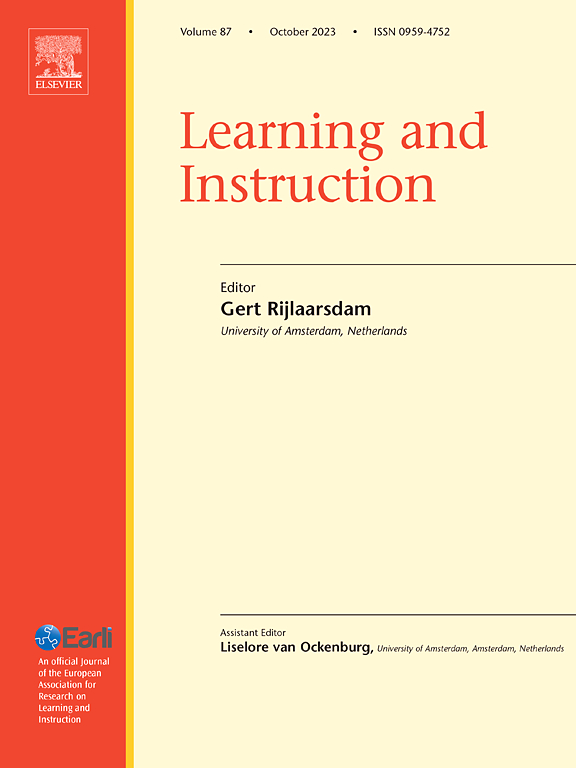一种促进空间思维能力的干预效果
IF 4.9
1区 教育学
Q1 EDUCATION & EDUCATIONAL RESEARCH
引用次数: 0
摘要
要在STEM领域取得成功,空间思维能力至关重要。他们的早期晋升可能有助于以后对STEM学科的掌握。先前的研究表明,空间思维可以通过练习、空间语言、具体化或策略训练独立地促进。整合多种有效成分可能会进一步提高儿童的技能,值得进一步研究。目的本研究评估在现实环境中对小学早期儿童进行的空间思维干预(a)是否能提高空间思维技能,(b)保持空间思维的动机,(c)对不同特征的学生同样有益。样本参与者是97名被提名参加课外充实计划的小学生。方法采用多组随机对照试验,采用测试前和测试后的测量方法,并采用候补对照组对多组分干预进行评价。构成要素包括空间语言、体现、规律和策略意识。我们采用多水平回归分析来评估干预对空间思维(即视角、二维和三维心理旋转)和空间思维动机的影响,并探讨差异效应。结果研究结果显示,在透视和二维心理旋转方面有显著的积极作用。年龄较小的儿童和先前换位思考能力较低的儿童尤其可能受益。三维心理旋转和动机均未受到显著影响。结论该结果为干预的有效性提供了初步证据。在保持空间思维的动力的同时,儿童表现出了增强的换位思考和二维思维旋转技能。结合多个组件有望促进小学早期的空间思维。本文章由计算机程序翻译,如有差异,请以英文原文为准。
Efficacy of an intervention to promote spatial thinking skills
Background
For success in STEM fields, spatial thinking skills are crucial. Their early promotion may support the later mastering of STEM subjects. Previous studies have suggested that spatial thinking can be promoted independently with practice, spatial language, embodiment, or strategy training. Integrating multiple effective components may further enhance children's skills, warranting further investigation.
Aims
This study evaluates whether a spatial thinking intervention applying a multicomponent approach in a real-world environment with children in their early primary school years (a) promotes spatial thinking skills while (b) maintaining motivation for spatial thinking and (c) being equally beneficial for students with different characteristics.
Sample
Participants were 97 primary school children previously nominated to attend an extracurricular enrichment program.
Methods
A multisite cluster randomized controlled field trial with pre- and posttest measures and a waitlist control group evaluated the multicomponent intervention. Components included spatial language, embodiment, and awareness of regularities and strategies. We used multilevel regression analyses to estimate the intervention's efficacy on spatial thinking (i.e., perspective taking, 2D and 3D mental rotation) and motivation for spatial thinking and explored differential effects.
Results
The findings revealed statistically significant positive effects on perspective taking and 2D mental rotation. Younger children and those with lower prior perspective-taking skills were particularly likely to benefit. Neither 3D mental rotation nor motivation were significantly affected.
Conclusions
The results provide initial evidence of the intervention's efficacy. Children demonstrated enhanced perspective-taking and 2D mental rotation skills while maintaining their motivation for spatial thinking. Combining multiple components holds promise for promoting spatial thinking during the early primary school years.
求助全文
通过发布文献求助,成功后即可免费获取论文全文。
去求助
来源期刊

Learning and Instruction
Multiple-
CiteScore
11.30
自引率
4.80%
发文量
109
期刊介绍:
As an international, multi-disciplinary, peer-refereed journal, Learning and Instruction provides a platform for the publication of the most advanced scientific research in the areas of learning, development, instruction and teaching. The journal welcomes original empirical investigations. The papers may represent a variety of theoretical perspectives and different methodological approaches. They may refer to any age level, from infants to adults and to a diversity of learning and instructional settings, from laboratory experiments to field studies. The major criteria in the review and the selection process concern the significance of the contribution to the area of learning and instruction, and the rigor of the study.
 求助内容:
求助内容: 应助结果提醒方式:
应助结果提醒方式:


